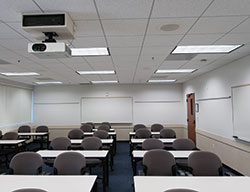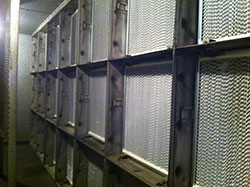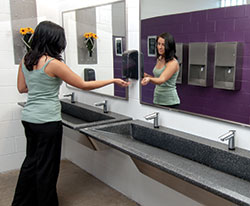view all Case Studies
Sensing Opportunities for Lighting Savings

When the opportunity arose to implement a major lighting retrofit at Pepperdine University's Drescher campus in Malibu, Calif., Les Thomas chose Energy TriPak wireless sensor controls from Lutron Electronics Co. to maximize energy efficiency.
October 14, 2013 -
Lighting
When the opportunity arose to implement a major lighting retrofit at Pepperdine University’s Drescher campus in Malibu, Calif., Les Thomas, the university’s manager of energy services, chose Energy TriPak® wireless sensor controls from Lutron Electronics Co. to maximize energy efficiency.
Thomas reduced labor and installation costs by working with the local utility and contractors. By complying with the program’s guidelines, the costs were 100 percent covered by incentives.
In addition to a fixture retrofit, Thomas identified two control opportunities:
• Install occupancy sensors to turn off lights in unoccupied offices and classrooms.
• Reduce HVAC costs in unoccupied classrooms by leveraging the occupancy sensors in a cost-effective way.
Thomas proposed a lighting control solution that included wireless occupancy sensors, switches and relay modules in each area to ensure lights turn off when the space is empty. In many rooms, wireless wall switches provide three-way control.
He also recognized the opportunity to reduce energy used by the HVAC system. To capture this opportunity, wireless contact closure modules (CCOs) were installed with the remote variable-air-volume (VAV) boxes, regulating air supply in each classroom. The CCO modules communicate directly with the same wireless occupancy sensors that control lighting.
Now, when the classrooms become unoccupied, lighting and cooling loads turn off automatically. The wireless CCO modules communicate with the wireless occupancy sensors through ceilings and walls, making it possible for the contractor to deliver an integrated solution within budget. The contractor installed the entire project over two weekends, minimizing disruption to campus operations.
Project stakeholders estimate the occupancy controls throughout the retrofit reduced lighting energy usage by 20-30 percent. And by integrating the VAV boxes wirelessly to the occupancy sensors, the solution reduces overall HVAC energy use in the classrooms by an additional 14 percent.
“Pepperdine’s centralized building management system allows us to easily evaluate when lights are on and off and where the HVAC use is affected,” Thomas says. “The occupancy sensors are doing their job to lower costs and reduce energy waste.
“Generally, if I’m not getting any negative feedback, I know everyone is happy. If the lights were turning off when people were in the space or students were cold in the classrooms, I would definitely know. Any time we can strike the perfect balance, we know we’ve made the best choice.”
Next
Read next on FacilitiesNet












